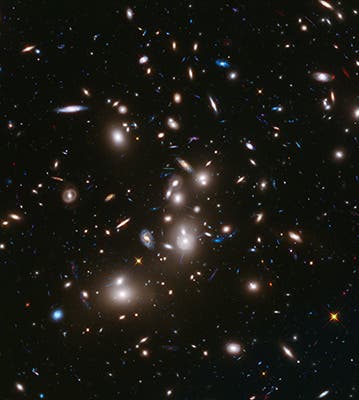
This year Hubble will embark on one its most ambitious projects yet, as it’s scheduled to glimpse farther away into the Universe than ever before. Six new “deep field” images are slated, and recently astronomers at Hubble have delivered the first to the public. The image reveals extremely faint, tiny galaxies that may be more than 12 billion light-years away, and offer tantalizing clues of things to come in the next parts of the project – findings that could show how the Universe looked like in its infancy and how the cosmos formed in its present form.
“It is the deepest view of the universe ever taken,” says project leader Jennifer Lotz of the Space Telescope Science Institute (STScI) in Baltimore. “We’re seeing things 10 or 20 times fainter than anything we’ve seen before.” Lotz and her colleagues presented the image today here at the 223rd meeting of the American Astronomical Society.
The image is shows the massive galaxy cluster Abell 2744, the deepest ever made of any cluster of galaxies. Some of the faintest and youngest galaxies ever detect in space are shown, after the telescope used 50 hours of light exposure. Some 3,000 ancient galaxies can be found in the cluster – their exact distance from Earth will be determined following observations taken by NASA’s Spitzer and Chandra space telescopes, which see in infrared and x-ray light, respectively.
A deep view
Hubble started its first Deep Field images in 1996, and since then thousands of previously undiscovered galaxies were identified in “blank patches” of space. In the new project, called Hubble “Frontier Fields,” researchers plan on peering farther than ever before, making use of advanced cameras mounted on the space telescope, combined with natural occurring gravitational lenses.
Gravitational lenses naturally magnify views of distant galaxies the lie behind very massive objects, like galaxy clusters. These massive objects cause light to warp and curve, so any object behind them will look brightened and magnified to observers on Earth. It’s a neat trick, one that astronomers are keen to exploit to make the best and deepest images of the Universe.
So far, data is preliminary and starting May this year, Hubble will collect more data on this first field, bringing the photo’s total exposure time to 103 hours, and over the next three years it will examine the other five Frontier Fields, which were chosen at spots where nature’s most powerful gravitational lenses lie.
“We’re really interested in knowing what happened in that first billion years of the universe,” Lotz says. “The thing that Frontier Fields is going to do is look for the galaxies that were basically small enough in those first billion years to turn into our Milky Way Galaxy. We want to know, when did galaxies like the Milky Way first come to be?”
Was this helpful?



